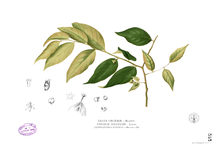Cleistanthus
| Cleistanthus | |
|---|---|

| |
| Cleistanthus orgyialis[1] | |
| Scientific classification | |
| Kingdom: | |
| (unranked): | |
| (unranked): | |
| (unranked): | |
| Order: | |
| Family: | |
| Tribe: | |
| Genus: | Cleistanthus |
| Synonyms[2] | |

Cleistanthus is a plant genus of the family Phyllanthaceae first described as a genus in 1848.[3][4] It is widespread in much of the Old World Tropics in Asia, Africa, Australia, and various oceanic islands.[2][5][6] Cleistanthus collinus is known for being toxic and frequently used for homicidal or suicidal purposes.[7]
- Species[2]
Cleistanthus collinus

Cleistanthus collinus (Karra) is a plant poison also called "oduvan" (Tamil), "Vadisaku" (Telugu) and Oduku (Malayalam). Ingestion of its leaves or a dicoction of its leaves causes hypokalemia (kaliuresis and cardiac arrhythmias),[8] metabolic acidosis, hypotension and hypoxia[9] probably due to distal renal tubular acidosis, ARDS and toxin induced vasodilatation respectively.[10][11][12] Hypokalemia and acidosis probably also induces rhabdomyolysis resulting in myoglobinuric renal failure and neuromuscular weakness.[13] Its effects are probably mediated by injury to the distal renal tubules, pulmonary epithelium and peripheral blood vessels due to glutathione depletion[14] (animal studies have shown benefit with N-acetylcysteine).[15]
Cleistanthin A and cleistanthin B are phytoconstituents of Cleistanthus collinus Roxb. Cleistanthin A and cleistanthin B are arylnaphthalide lignans. They have been reported to be toxic substances responsible for poisoning. Cleistanthin A is also present in Phyllanthus toxodiifolius.[16]
Cleistanthus sankunnianus
This species found in the herbal garden at Kottakkal Aryavaidyasala (Kerala, India) was described by V.V. Sivarajan & Indu Balachandran in the year 1984. The glabrous ovary brings the species under Sects. Australis (Jablonszky) and Nanopetalum (Hassk.). The persistent calyx, sessile male flowers and non-stripiate caplsules are similar to Stripulati (Jabl). The species differes from Stripulati (Jabl) because of its glabrous ovary. The species differs from Cleistanthus travencorensis in several details. The species name is after P. Sankunni Varier, the founder of Arya Vaidya Sala, Kottakkal.[17]
Cleistanthus schlechteri
Cleistanthus schlechteri var. schlechteri (False Tamboti, Zulu: Umzithi) is a protected tree in South Africa.[18]
- Identification[19]
Small tree (up to 6 m), deciduous, multi or single stemmed, fairly upright and minimally spreading crown. Many twigs and branches, trunks pale buff-grey, bark cracks into small, flat, more or less rectangular blocks.
- Leaves[19]
Simple, borne on very short, gnarled, lateral twigs. Very small, oval to obovate, smooth, glabrous, marginally entire, dark green and glossy above.
- Flowers[19]
Both the sexes are borne on separate trees in small bunches, yellow-green to pale green; (October/November).
- Fruits[19]
Capsules 1.0 x 0.8 cm, glabrous and glossy; brown to dark-brown when ripe (January/February).
References
- ^ illustration circa 1880, from Francisco Manuel Blanco (O.S.A.) - Flora de Filipinas
- ^ a b c Kew World Checklist of Selected Plant Families
- ^ Hooker, Joseph Dalton, Planchon, Jules Émile. 1848. Hooker's Icones Plantarum 8: , pl. DCCLXXIX in Latin with full-page line drawing
- ^ Tropicos, Cleistanthus Hook. f. ex Planch.
- ^ Govaerts, R., Frodin, D.G. & Radcliffe-Smith, A. (2000). World Checklist and Bibliography of Euphorbiaceae (and Pandaceae) 1-4: 1-1622. The Board of Trustees of the Royal Botanic Gardens, Kew.
- ^ Flora of China Vol. 11 Page 172 闭花木属 bi hua mu shu Cleistanthus J. D. Hooker ex Planchon, Icon. Pl. 8: t. 779. 1848.
- ^ 5. Bose A, Sandal Sejbaek C, Suganthy P, Raghava V, Alex R, Muliyil J, et al. Self-harm and self-poisoning in southern India: Choice of poisoning agents and treatment. Trop Med Int Health. 2009;14:761–5. (doi: 10.1111/j.1365-3156.2009.02293.x.)
- ^ Thomas, K; Dayal, AK; Narasimhan, Alka G; Seshadri, MS; Cherian, AM; Kanakasabapathi, Molly B (1991). "Metabolic and Cardiac effects of Cleistanthus Collinus poisoning". J Assoc Physicians India. 39 (4): 312–314.
- ^ Subrahmanyam, DK; Mooney, T; Raveendran, R; Zachariah, B. A (Nov 2003). "Clinical and laboratory profile of Cleistanthus collinus poisoning". J Assoc Physicians India. 51: 1052–4.
- ^ Eswarappa, S.; Chakraborty, A R; Palatty, B U; Vasnik, M (2003). "Cleistanthus Collinus Poisoning: Case Reports and Review of the Literature". Clinical Toxicology. 41 (4): 369–72. doi:10.1081/clt-120022005.
- ^ Benjamin SPE, M Edwin Fernando, JJ Jayanth, Preetha B; Cleistanthus collinus poisoning. J Assoc Physicians India 2006 Sep; 54:742-44
- ^ Nampoothiri, K; Chrispal, A; Begum, A; Jasmine, S; Gopinath, KG; Zachariah, A (Mar 2010). "A clinical study of renal tubular dysfunction in Cleistanthus collinus (Oduvanthalai) poisoning". Clin Toxicol (Phila). 48 (3): 193–7. doi:10.3109/15563651003641786.
- ^ Eswarappa, Benjamin SPE (Jan 2007). "Renal failure and neuromuscular weakness in Cleistanthus collinus poisoning". J Assoc Physicians India. 55: 85–86.
- ^ Sarathchandra, G; Balakrishnamoorthy, P. "Acute toxicity of Cleistanthus collinus, an indigenous poisonous plant in Cavia procellus". Journal of Environmental Biology. 1998: 145–8.
- ^ Annapoorani, KS; Damodaran, C; Chandrasekharan, P (1986). "A promising antidote to Cleistanthus collinus poisoning". J Sci Soc Ind. 2: 3–6.
- ^ Parasuraman, S; Raveendran, R (2012). "Diuretic effects of cleistanthin a and cleistanthin B from the leaves of cleistanthus collinus in wistar rats". J Young Pharm. 4: 73–7. doi:10.4103/0975-1483.96616. PMC 3385220. PMID 22754257.
{{cite journal}}: CS1 maint: unflagged free DOI (link) - ^ V. V., Sivarajan; Balachandran, Indu (1985). "Cleistanthus sankunnianus, a New Species of Euphorbiaceae from India". Kew Bulletin. 40 (1): 121–123. JSTOR 4108485.
- ^ "Protected Trees" (PDF). Department of Water Affairs and Forestry, Republic of South Africa. 3 May 2013. Archived from the original (PDF) on 2010-07-05.
{{cite web}}: Unknown parameter|deadurl=ignored (|url-status=suggested) (help) - ^ a b c d Van Wyk, Piet (2008). Field guide to the TREES of the Kruger National Park. Cape Town: Struik Publishers. p. 126. ISBN 978-1-77007-759-1.
